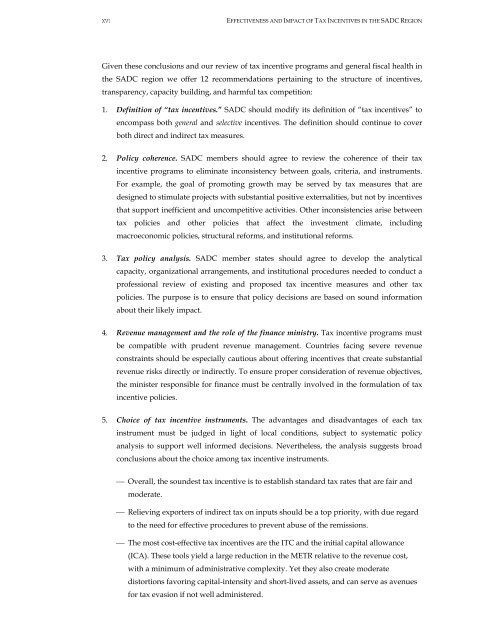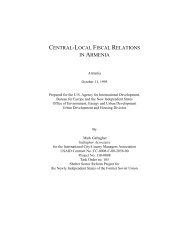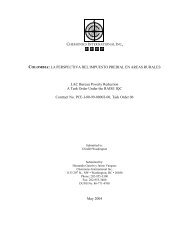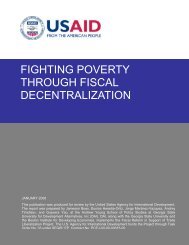Effectiveness and Economic Impact of Tax Incentives in the SADC ...
Effectiveness and Economic Impact of Tax Incentives in the SADC ...
Effectiveness and Economic Impact of Tax Incentives in the SADC ...
Create successful ePaper yourself
Turn your PDF publications into a flip-book with our unique Google optimized e-Paper software.
XVI EFFECTIVENESS AND IMPACT OF TAX INCENTIVES IN THE <strong>SADC</strong> REGION<br />
Given <strong>the</strong>se conclusions <strong>and</strong> our review <strong>of</strong> tax <strong>in</strong>centive programs <strong>and</strong> general fiscal health <strong>in</strong><br />
<strong>the</strong> <strong>SADC</strong> region we <strong>of</strong>fer 12 recommendations perta<strong>in</strong><strong>in</strong>g to <strong>the</strong> structure <strong>of</strong> <strong>in</strong>centives,<br />
transparency, capacity build<strong>in</strong>g, <strong>and</strong> harmful tax competition:<br />
1. Def<strong>in</strong>ition <strong>of</strong> “tax <strong>in</strong>centives.” <strong>SADC</strong> should modify its def<strong>in</strong>ition <strong>of</strong> “tax <strong>in</strong>centives” to<br />
encompass both general <strong>and</strong> selective <strong>in</strong>centives. The def<strong>in</strong>ition should cont<strong>in</strong>ue to cover<br />
both direct <strong>and</strong> <strong>in</strong>direct tax measures.<br />
2. Policy coherence. <strong>SADC</strong> members should agree to review <strong>the</strong> coherence <strong>of</strong> <strong>the</strong>ir tax<br />
<strong>in</strong>centive programs to elim<strong>in</strong>ate <strong>in</strong>consistency between goals, criteria, <strong>and</strong> <strong>in</strong>struments.<br />
For example, <strong>the</strong> goal <strong>of</strong> promot<strong>in</strong>g growth may be served by tax measures that are<br />
designed to stimulate projects with substantial positive externalities, but not by <strong>in</strong>centives<br />
that support <strong>in</strong>efficient <strong>and</strong> uncompetitive activities. O<strong>the</strong>r <strong>in</strong>consistencies arise between<br />
tax policies <strong>and</strong> o<strong>the</strong>r policies that affect <strong>the</strong> <strong>in</strong>vestment climate, <strong>in</strong>clud<strong>in</strong>g<br />
macroeconomic policies, structural reforms, <strong>and</strong> <strong>in</strong>stitutional reforms.<br />
3. <strong>Tax</strong> policy analysis. <strong>SADC</strong> member states should agree to develop <strong>the</strong> analytical<br />
capacity, organizational arrangements, <strong>and</strong> <strong>in</strong>stitutional procedures needed to conduct a<br />
pr<strong>of</strong>essional review <strong>of</strong> exist<strong>in</strong>g <strong>and</strong> proposed tax <strong>in</strong>centive measures <strong>and</strong> o<strong>the</strong>r tax<br />
policies. The purpose is to ensure that policy decisions are based on sound <strong>in</strong>formation<br />
about <strong>the</strong>ir likely impact.<br />
4. Revenue management <strong>and</strong> <strong>the</strong> role <strong>of</strong> <strong>the</strong> f<strong>in</strong>ance m<strong>in</strong>istry. <strong>Tax</strong> <strong>in</strong>centive programs must<br />
be compatible with prudent revenue management. Countries fac<strong>in</strong>g severe revenue<br />
constra<strong>in</strong>ts should be especially cautious about <strong>of</strong>fer<strong>in</strong>g <strong>in</strong>centives that create substantial<br />
revenue risks directly or <strong>in</strong>directly. To ensure proper consideration <strong>of</strong> revenue objectives,<br />
<strong>the</strong> m<strong>in</strong>ister responsible for f<strong>in</strong>ance must be centrally <strong>in</strong>volved <strong>in</strong> <strong>the</strong> formulation <strong>of</strong> tax<br />
<strong>in</strong>centive policies.<br />
5. Choice <strong>of</strong> tax <strong>in</strong>centive <strong>in</strong>struments. The advantages <strong>and</strong> disadvantages <strong>of</strong> each tax<br />
<strong>in</strong>strument must be judged <strong>in</strong> light <strong>of</strong> local conditions, subject to systematic policy<br />
analysis to support well <strong>in</strong>formed decisions. Never<strong>the</strong>less, <strong>the</strong> analysis suggests broad<br />
conclusions about <strong>the</strong> choice among tax <strong>in</strong>centive <strong>in</strong>struments.<br />
⎯ Overall, <strong>the</strong> soundest tax <strong>in</strong>centive is to establish st<strong>and</strong>ard tax rates that are fair <strong>and</strong><br />
moderate.<br />
⎯ Reliev<strong>in</strong>g exporters <strong>of</strong> <strong>in</strong>direct tax on <strong>in</strong>puts should be a top priority, with due regard<br />
to <strong>the</strong> need for effective procedures to prevent abuse <strong>of</strong> <strong>the</strong> remissions.<br />
⎯ The most cost-effective tax <strong>in</strong>centives are <strong>the</strong> ITC <strong>and</strong> <strong>the</strong> <strong>in</strong>itial capital allowance<br />
(ICA). These tools yield a large reduction <strong>in</strong> <strong>the</strong> METR relative to <strong>the</strong> revenue cost,<br />
with a m<strong>in</strong>imum <strong>of</strong> adm<strong>in</strong>istrative complexity. Yet <strong>the</strong>y also create moderate<br />
distortions favor<strong>in</strong>g capital-<strong>in</strong>tensity <strong>and</strong> short-lived assets, <strong>and</strong> can serve as avenues<br />
for tax evasion if not well adm<strong>in</strong>istered.











